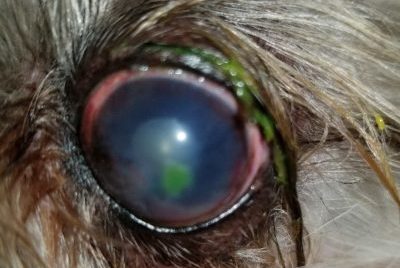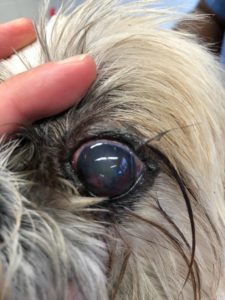Corneal Ulcers in Dogs

Corneal Ulcers in Dogs
Corneal ulcers are one of the more common eye conditions in pets. A few weeks ago, one of my geriatric patients came to see me for a goopy eye. Because he is a short-nosed dog, with bulgy eyes, he is predisposed to developing corneal ulcers, and that ended up being the diagnosis This little guy also has “dry eye” and, without moisture from tears, his eye has additional risk of developing a corneal ulcer.
The problem
An ulcer is simply the loss of the normal surface layer of cells. Loss of the protective surface layer exposes blood vessels and causes bleeding like in a bleeding gastric ulcer. In the case of the eye, the cornea refers to the clear covering of the eye, and the loss of its surface layer is very painful in pets. The presence of a corneal ulcer weakens the eyeball and makes it prone to rupture. A dog with a corneal ulcer typically has a red eye, squints and often has a thick ocular discharge.
The diagnosis
To diagnose a corneal ulcer, we use a special strip of paper impregnated with a dye called fluorescein. Fluorescein will not stain a healthy cornea, but it turns a cornea with a surface defect bright green. The first photo shows my patient’s corneal ulcer stained green with fluorescein. The green around the upper edge of the eye is dye trapped in the thick ocular discharge. Note how red the white of the eye is.
The treatment
In dogs with corneal ulcers, the iris (the colored part of the eye) spasms causing pain. Veterinarians use atropine ointment to dilate the iris and decrease pain. Ocular antibiotic drops or ointments are administered multiple times a day to prevent infection and speed healing.
The outcome

Because of dry eye and the bulgy eyes, this ulcer took a couple of weeks to heal, but as you can see in the second photograph there is no green dye on the cornea. There is a little pink scar which will contract over time and become white. The scar will not affect his vision. There is not as much discharge and the eye is also much less red.
If your dog has a red eye or increased ocular discharge, seek veterinary care immediately to alleviate the pain of a corneal ulcer and also to protect your dog’s vision.






























